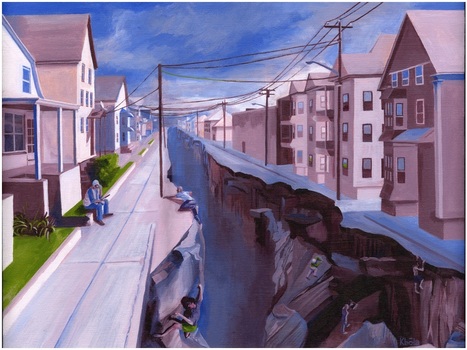While touring Kevin Babola's art studio yesterday, I found this thought-provoking piece entitled ‘Political Landscapes.’ I greatly enjoyed my conversation with the artist about the political, economic and urban visions that went into this painting. The conceptual idea behind this painting started when the artist was exploring the neighborhoods of New Bedford, MA and noticed how a sense of place can change very quickly. I dare say most cities have areas similar to the one portrayed here where the socioeconomic character changes very abruptly. While physically it might be very easy to cross from the side of the street with tenements to the neighborhood with single family homes, making that transition permanent is incredibly difficult.
Questions to ponder: what leads to cities having abrupt changes in the urban fabric? What might this chasm represent to people on either side of the divide? How does this impact the neighborhood institutions (schools, local government, etc.)? Please visit the artist's webpage at: http://www.kbolaillustration.com




 Your new post is loading...
Your new post is loading...









The picture ‘Political Landscapes,’ is a portrait of the haves and the have not’s and it illustrates the widening chasm of socioeconomic levels with the top 1% gaining and the rest steadily losing ground.
The decline of industry very often leads to the decline in jobs, schools and local government. With the erosion of the tax base cities are no longer able to maintain these institutions.
This pictures shows the difference between the city and suburbs. Even in the same city, you can have some parts that look more economically wealthier. But looking at it from a political view, I would guess that the whole in the ground that divides the two neighborhoods would be the line that divides democrats and republicans. City folk tend to vote more democrat because they want the government to assist the people. WHile Republicans tend to look out more for themselves.